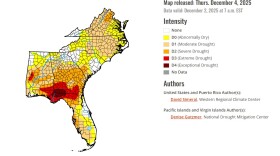If you saw images of a tropical storm off Florida's West Coast on Sunday and didn't know if the pictures were from this year or last you'd have had a tough time figuring out which tropical storm you were looking at.
Was it a replay of last year’s Hurricane Idalia curving to hit the Cedar Key area in the Big Bend? Or was it a current image of Hurricane Debby graduating from Tropical Storm Debby curving to hit the Cedar Key area in the Big Bend?
Also forecast to be about the same are the particulars of the side-swipe expected for us here in Southwest Florida: gusty winds, occasional rain bands, and rainfall estimates of up to 10 inches over three or four days. And perhaps a tornado or two.
As of early Sunday, then-Tropical Storm Debby was forecast to be a rather typical tropical system, forming at a rather typical time of the year, heading for landfall at a rather typical coastline in Florida.’
*Yawn*
Last year we needed the rain. In Lee County alone there was a deficit of more than a foot. Hurricane Idalia’s drenching in 2023 was well-timed and sucked up with gusto by the earth.
This year Lee County is in the midst of its wettest year since the late 1800s, with nearly four extra inches of rain falling from January to June.
By mid-afternoon Sunday, Fort Myers Beach was once again under feet-worth of storm surge. Debby's surge was nowhere near Ian's, as proven by the very existence of that one Florida Man who always shows up paddling his kayak through grey, foamy, surge.
But I'm sure Debby's surge reigned enough havoc to — like Ian's much deeper waters two years ago — ruin what was a strong sea turtle nesting season underway.
With the ground saturated and countless ponds and lakes full from the rains earlier this year, Hurricane Debby's polluted stormwater is going to gush down Southwest Florida rivers, into its bays, and out into the Gulf of Mexico.
I’m not yawning anymore.
If my arguably educated guess is correct Hurricane Debby's stormwater, much like Ian's, will transport tons of nutrient pollution swept from front yards, roadways, and farms downriver to where it will first threaten people's health and then contribute to red tide.
Can it get worse? Yep.
The Florida Department of Health in Manatee County advised Saturday morning in a press release that there was a problem at the popular recreation areas of Palma Sola South and Bayfront Park.
“Swimmers are strongly advised to avoid these beaches due to the presence of excrement in the water,” the DEP wrote in a release. “The bacterial levels far exceed safety standards for recreational use."
(Why do agencies always seem to put out releases with bad news – dangerous even – late on a Friday or early or a Saturday as if we in the press will “miss it?” Wouldn't anybody want us to amplify such things with all that we’ve got?)
“Tests reveal dangerous levels of enterococcus bacteria, which originates from human and animal waste, polluting the waters,” the department’s press release stated. “Exposure to this sewage-tainted water significantly increases the risk of illness, including gastrointestinal diseases, ear infections, and skin rashes.
Late last Friday, the DEP division in Lee County issued a nearly as dire warning about the rampant amount of blue-green algae polluting popular areas of the Caloosahatchee River after the harmful algae has been found in the canals for months.
Perhaps Hurricane Debby's rainwater may — wash all that pollution out to sea, clearing the excrement from coastal hot spots and toxic algae and garbage from rivers.

The bad news is the last time this happened, when Hurricane Ian power-washed Southwest Florida, all the accumulated nitrogen, phosphorus, and other chemicals spread out in the Gulf of Mexico and fed fledgling red tides for more than half a year from Tampa Bay south to Ten Thousand Islands.
That, in effect, sent a different type of spoil onto the beaches of the region. The red tide spread its acrid smells airborne and the resulting fish kill left tens of thousands of rancid fish carcasses baking on the shores.
Then again, there is no telling what Hurricane Debby will do.
Tropical systems can do anything.
Debby is not forecast to do a loopy-loop and head back toward Southwest Florida, but she could. Debby isn’t expected to blow up overnight into a Category 5 and engulf the entire Gulf Coast of Florida, but it can.
Time will tell if any of this leads to another round of red-tide-itis.
Now it's time to grab the popcorn and enjoy another chapter of WGCU’s Water Quality Report.
RED TIDE
The Florida Fish and Wildlife Conservation Commission sampled for the red tide organism, Karenia brevis, and it was not observed in samples collected offshore of Sarasota, Charlotte, Lee, Collier, or Monroe counties.
No reports of fish kills nor respiratory irritation suspected to be related to red tide were reported in Southwest Florida during the past week.
The Clinic for Wildlife Rehabilitation on Sanibel Island had zero patients, which is always great news.
BLUE-GREEN ALGAE
A health alert remains in effect for blue-green algae in canals connected to the Caloosahatchee River including the Bimini, Atlantic, and Pioneer. Specks and lines of the cyanobacteria were seen from the Franklin Locks south to the Midpoint Bridge.
Using satellite imagery of Lake Okeechobee provided by NASA, the Florida Department of Environmental Protection found about half of the lake’s 760 square-mile-surface was covered in blue-green algae.
What is red tide?
Red tide is one type of harmful algal bloom caused by high concentrations of the toxic dinoflagellate K. brevis, which is a type of microscopic algae found in the Gulf of Mexico.
Red tide typically forms naturally offshore, commonly in late summer or early fall, and is carried into coastal waters by winds and currents. Once inshore, these opportunistic organisms can use nearshore nutrient sources to fuel their growth.
Blooms typically last into winter or spring, but in some cases, can endure for more than one year.
Is red tide harmful?
K. brevis produces potent neurotoxins that can be harmful to the health of both wildlife and people. Wind and wave action can break open K. brevis cells and release toxins into the air. This is why you should monitor conditions and stay away from beaches where red tide is in bloom.
People in coastal areas can experience varying degrees of eye, nose, and throat irritation during a red tide bloom. Some individuals with chronic respiratory conditions like asthma or chronic lung disease might experience more severe symptoms.
Red tide toxins can also affect the central nervous system of fish and other marine life, which can lead to fish kills.
What causes red tide?
A red tide bloom develops naturally, but recent studies have discovered mankind's infusion of other nutrients into the mix can make the red tide last longer or get stronger. But biology (the organisms), chemistry (natural or man-made nutrients for growth) and physics (concentrating and transport mechanisms) interact to produce the algal bloom. No one factor causes the development of a red tide bloom.
What is blue-green algae?
Blue-green algae, also known as cyanobacteria, are a group of organisms that can live in freshwater, saltwater or brackish water.
Large concentrations, called blooms, can change the water color to blue, green, brown, orange or red. Some cyanobacterial blooms can look like foam, scum, or mats on the surface of freshwater lakes and ponds. As algae in a cyanobacterial bloom die, the water may smell like something with a naturally unpleasant odor has now started to rot, too.
Is blue-green algae harmful?
Different types of blue-green algal bloom species can look different and have different impacts. However, regardless of species, many types of blue-green algae can produce toxins that can make you or your pets sick if swallowed or possibly cause skin and eye irritation.
The FDEP advises staying out of water where algae is visibly present as specks or mats or where water is discolored. Pets or livestock should not come into contact with algal bloom-impacted water or with algal bloom material or fish on the shoreline. If they do, wash the animals right away.
What causes blue-green algae?
Blue-green algae blooms occur when the algae that are typically present grow in numbers more than normal. Within a few days, a bloom can cause clear water to become cloudy.
Winds tend to push the floating blooms to the shore where they become more noticeable. Cyanobacterial blooms can form in warm, slow-moving waters that are rich in nutrients. Blooms can occur at any time, but most often occur in late summer or early fall.
If any major type of water quality alert is issued, you can find the details here in WGCU’s Water Quality Report.
Sign up for WGCU's monthly environmental newsletter, the Green Flash, today.
WGCU is your trusted source for news and information in Southwest Florida. We are a nonprofit public service, and your support is more critical than ever. Keep public media strong and donate now. Thank you.








